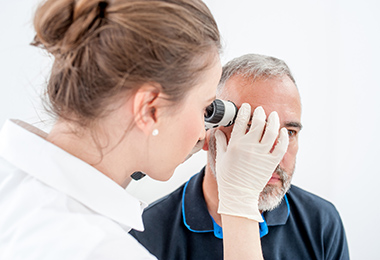Skin Cancer of the Head and Neck
Featured Expert:
What is skin cancer of the head and neck?
Skin malignancies are the most common cancers in the United States, responsible for more than half of all new cancer cases.
Types of skin malignancies:
- Melanoma — the least common form of skin cancer, but responsible for more deaths per year than squamous cell and basal cell skin cancers combined. Melanoma is also more likely to spread and may be harder to control.
- Nonmelanoma malignancies:
- Squamous cell cancer — the second-most common skin cancer. It's more aggressive and may require extensive surgery, depending on location and nerve involvement.
- Basal cell cancer — the most common form of skin cancer. It is rarely fatal but can be locally aggressive.
These skin malignancies are typically caused by ultraviolet radiation from exposure to the sun and tanning beds.
What are the symptoms of skin cancer of the head and neck?
Skin cancers usually present as an abnormal growth on the skin. The growth may have the appearance of a wart, crusty spot, ulcer, mole or sore. It may or may not bleed and can be painful. If you have a preexisting mole, any change in the characteristics of this spot - such as a raised or an irregular border, irregular shape, change in color, increase in size, itching or bleeding - are warning signs of melanoma. Sometimes the first sign of melanoma or squamous cell cancer is an enlarged lymph node.
Johns Hopkins Head and Neck Cancer Specialists

Our head and neck surgeons and speech-language pathologists take a proactive approach to cancer treatment. Meet the Johns Hopkins specialists who will work closely with you during your journey.
What are the risk factors for skin cancer of the head and neck?
-
Sun exposure
-
Tanning bed exposure
-
Immunosuppressive medications (like those taken by transplant patients)
-
Prior radiation to the head and neck area
These skin malignancies are typically caused by ultraviolet radiation from exposure to the sun and tanning beds.
What are the symptoms of skin cancer of the head and neck?
Skin cancers usually present as an abnormal growth on the skin. The growth may have the appearance of a wart, crusty spot, ulcer, mole or sore. It may or may not bleed and can be painful. If you have a preexisting mole, any change in the characteristics of this spot — such as a raised or irregular border, irregular shape, change in color, increase in size, itching or bleeding — are warning signs of melanoma. Sometimes, the first sign of melanoma or squamous cell cancer is an enlarged lymph node.
What are the risk factors for skin cancer of the head and neck?
- Sun exposure.
- Tanning bed exposure.
- Immunosuppressive medications (such as those taken by transplant patients).
- Prior radiation to the head and neck area.
How is skin cancer of the head and neck diagnosed?
Diagnosis is made by clinical exam and a biopsy. Basal cell and squamous cell cancers are staged by size and extent of growth. Basal cell cancers rarely metastasize to lymph nodes, but they can grow quite large and invade local structures. Squamous cell cancers have a much higher incidence of lymph node involvement in the neck and parotid gland and can spread along nerves.
Melanoma is staged, based not on size but on how deeply it invades the skin layers. Therefore, a superficial or shave biopsy will not provide accurate staging information used to guide treatment. Melanomas can have a very unpredictable course and may spread to distant organs. Melanomas with intermediate thickness often require sentinel node biopsy, a surgical procedure performed by a head and neck surgeon, to determine if microscopic spreading to lymph nodes has occurred.
Skin cancer of the head and neck treatment
Many early-stage small basal cell cancers or squamous cell cancers can be removed by Mohs surgery, a technique that spares normal tissue through repeated intraoperative margin testing, removing only the cancer and leaving adjacent normal tissue. Tumors with nerve involvement, lymph node involvement or of a large size are not suitable for Mohs surgery. They require a multimodality approach to treatment, with formal surgical resection and adjuvant radiation or chemotherapy.
Melanoma is more likely to spread, and aggressive surgical resection with wide margins is required, in addition to radiation and/or chemotherapy.
Johns Hopkins Head and Neck Cancer Surgery

Our team offers comprehensive treatments for cancers affecting the nasal passages, sinuses, the throat and nearby areas. Our head and neck surgeons work closely with medical and radiation oncologists, endocrinologists and other specialists to provide well-rounded care.







